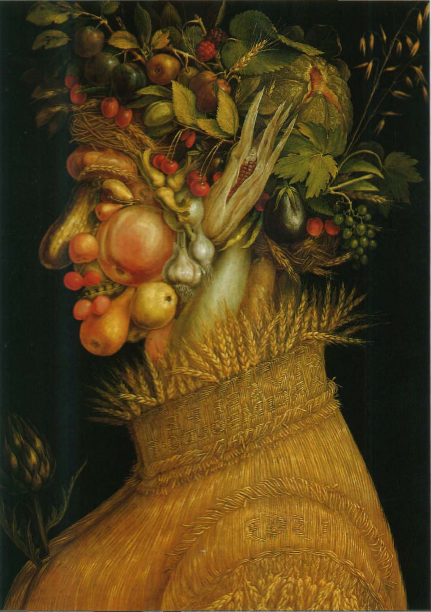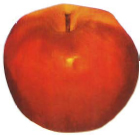

Here we stand, on the threshold of a whole new century in which the joys of excess may prove to be even more unrestrained, not to mention more creative, than ever before. The new millennium brings with it the heady possibility of leaving the sins of the past thousand years behind and trading up to a whole new standard of deliciously sinful behavior. If we are to be thrust into a new age filled with even more insatiable appetites and greater self-indulgence, now might be the perfect time to examine more closely the most comforting of the Seven Deadly Sins, gluttony.
“Let us eat and drink for tomorrow we shall die.”
–ISAIAH 22:13
FORBIDDEN FRUIT SALAD

Long after the Old Testament was written, theologians may have labeled Eve’s desire for that infamous apple of her eye Original Sin, but any card-carrying food fanatic will recognize at once what her problem was. Temptation, in Eve’s case, was that most succulent of apples, touted by that cheeky serpent as simply irresistible.
Esau was even more emotional when it came to dealing with his food fantasies. He was so driven by his hunger that he bartered away his birthright for a bowl of pottage. Or maybe he was just in the mood for a mess of lentils.
The interpretation of sin in the old days was definitely in the eyes of the beholder. If the beholder happened to be the Church, then sin was characterized as anything that took one away from the dedicated worship of God.
In the 600s, the Koran, the sacred book of Islam, offered: “Children of Adam, put your minds and bodies in a state of tidiness at every time and place of worship, and eat and drink but be not immoderate.” (7:32)
All in all, gluttony, or gorging oneself into a sublime state of bliss, was a spiritual breach of the contract to worship God above all else. Put that in your Peking Duck and smoke it.

Summer, 1563, by Giusseppe Arcimboldo
KUNSTHISTORISCHES MUSEUM, VIENNA
VEXATIONAL

I’m vexed as a stinging nettle
By cowards waving flags with mettle;
By hunting hawks in sorry fettle,
By skimpy meat in a mammoth kettle.
I hate by good St. Martin’s sign,
A pint of water drowning in my wine!
–Monk of Montaudon, circa 1200

THE BRITISH LIBRARY
DEPRIVE AND CONQUER

In the 1200s, Thomas Aquinas, in his most famous theological work, Summa Theologica, expanded and refined the ground rules for understanding the meaning of Christian doctrine. Heading the list of ways errant members of the Church found to exclude God from their lives was a short and, by today’s standards, seemingly harmless clutch of transgressions, which became known as the Seven Deadly Sins. At the very top was “Vainglory,” the sin of pride, from which he believed the other sins such as lust, envy and anger were born. Greed, gluttony, sloth, he considered small potatoes.
Unlike the biblically correct Ten Commandments, which focused on the very fabric of morality as well as respect for human life, the Seven Deadly Sins formed a category of minor vices that were, nonetheless, viewed as a slippery path down which the sinner could be assured of a relentless slide into evil. The most pitiful of these sinners were those who wore their transgression with the visibility of the chubby Michelin Man, and so were easy targets for the Church’s relentless potshots. Sloth could be hidden behind closed doors; envy could be disguised as admiration tinged with just a hint of negativity. Greed could maintain its somewhat legitimate facade of ambition, but gluttony, because of its bloated nature, was an all-too-evident expansion of the waistline at the expense of the soul.
As the years fell away, so did the severity of the Church’s responses to Gluttony and his six siblings. Instead of raining on its parishioners’ picnic, why not focus, instead, on the behavior of monks within the confines of their cloistered, rarefied society? After all, their job description required them to practice a selfless dedication to God. The fly in the monastic soup turned out to be that medieval monasteries were not only dedicated to God but also to the overflowing wine goblet and the groaning board. Somehow, the monks managed to conduct the good works of the Church with the rollicking abandon of a never-ending Bar Mitzvah. From the look of their bulging robes, it was all too apparent that fasting and deprivation were a matter of somewhat loose religious interpretation.
“Gluttons dig their graves with their teeth.”
–GERMAN PROVERB

“Temptations can be got rid of.
How?
By yielding to them.”
–HONORÉ DE BALZAC
SACRED CHOW

During the Middle Ages the richest of the monasteries became the settings for the Church’s most sumptuous entertaining. Most of the wine of their vineyard grapes filled not only the cup of the abbot but those of his esteemed guests as well. To best display the bounty that God had provided, huge banquets were mounted not only to celebrate the endless feast days that punctuated the Church’s calendar but also to honor visiting religious and royal dignitaries. Even if the accepted propaganda flowing from the abbey was that devotion to one’s belly was an ungodly waste of time, the nonstop gustatory reveling taking place within its great halls rivaled the culinary orgies of old Rome. All in all, the sin of gluttony became a lot less deadly as practiced by those who could whisper regularly into the ear of the Almighty.
Today, gluttony is often regarded by a more sympathetic society, as are most other characterological flaws, as a psychological problem with labels such as compulsive eating disorder, low self-esteem, obsessive or masochistic behavior. The slavish worship of the id has replaced many of the Church’s favorite taboos. Sin, as Thomas Aquinas knew it, no longer requires a serious talk with your rabbi or priest, just a trip to your local library, which is filled to the rafters with self-help books. Written by legions of mental health professionals, they are dedicated to changing the old-time sinner into a New Age saint. On the other hand, gluttony may be viewed as a harmless overindulgence, to be cured not by soul-searching but by the occasional dose of Pepcid AC. And so, gentle reader, no matter how you choose to respond to the least sinful of the Seven Deadly Sins, there can be no doubt that gluttony is the one that best represents the ongoing joys of conspicuous consumption.
“He who has only coarse food to eat
and water to drink...
will, without looking for it,
find happiness.”
–CONFUCIUS

Vatican kitchen detail from Opéra by Bartolomeo Scarpi, chef of Pope Pius V, Venice, 1596
LOURVE © PHOTO RMN

The Wedding at Cana, 1563, by Paolo Veronese
COURTESY OF NEW YORK ACADEMY OF MEDICINE LIBRARY

BIRTHRIGHT POTTAGE
1 (3 ½ pound) chicken |
1 rutabaga or turnip, diced (use half if rutabaga is large) |
2 cans (46-ounce) chicken broth, or 12 cups homemade broth |
1 medium onion, chopped |
3 tablespoons olive oil |
2 leeks, carefully washed and chopped |
2 carrots, diced |
1 preserved lemon, * finely chopped, or juice of 1 lemon |
About 1 pound (3 or 4, depending on size) potatoes, diced |
Salt and pepper to taste |
½ cup dry lentils, preferably yellow |
|

*T raditional preserved lemons must be made a month ahead. But Paula Wolfert offers a quicker version in Couscous and Other Good Foods from Morocco: With a razor blade, make 8 fine 2-inch vertical incisions in the peel around each lemons. (Do not cut deeper than the membrane that protects the pulp.) Place incised lemons in stainless-steel saucepan with plenty of salt and water to cover and boil until peels become very soft. Place in a clean jar, cover with cooled cooking liquor, and leave to pickle for approximately 5 days. Unlike the 30-day lemons, these lemons will not keep up to a year, or even very long, but are perfectly acceptable if used soon.
TO POACH CHICKEN: Place in a large stockpot, cover with broth, preferably homemade (add water if you do not have enough broth). Bring to boil, immediately lower heat and simmer until chicken meat is falling off the bones.
Using tongs, lift chicken pieces out of pot and set aside to cool. When cool enough to handle, remove meat from bones. Shred chicken meat and pour a little broth over it and store, covered, in refrigerator until ready to use. (If using canned broth, return skin and bones to pot and simmer for an hour longer to enrich flavor.)
Strain broth through a sieve into a container, discard skin and bones, and refrigerate broth overnight, or until it is chilled enough so that all the fat has risen to the top. Remove fat and discard. Set broth aside.

TO MAKE POTTAGE: Heat olive oil in a large stockpot. Add diced carrots, potatoes and lentils, then rutabaga and finally onion and leeks. After each vegetable is added, stir it around to coat with oil and pan-roast for a few minutes. (This makes a real difference to the flavor of the pottage.)
Add 8 cups of broth (or add enough water to the broth to make 8 cups) and 1 to 2 teaspoons of salt, bring to a boil and simmer about ½ hour, until vegetables are tender. Using a potato masher, mash some of the vegetables slightly to thicken pottage. If soup is too thick, add water to achieve desired consistency. Taste for seasoning; add salt, if needed.
Add reserved chicken and preserved lemon, or lemon juice, simmer gently for 20 minutes. Makes 10 servings.

A lesson on abstention.
SCRIPTURE CAKE
1 ½ cups chopped dried figs (Nahum 3:12) |
1 teaspoon baking soda |
2 ¼ cups water (Judges 4:19) |
1 tablespoon cinnamon (Revelation 18:13) |
1 cup softened butter (Psalms 55:21) |
2 teaspoons ginger (I KINGS 10:2) |
2 cups sugar (Jeremiah 6:20) |
½ teaspoon ground cloves |
2 tablespoons honey (Exodus 3:8) |
1 teaspoon nutmeg |
6 eggs (Isaiah 10:14) |
1 cup milk (Genesis 18:8) |
3 ¾ cups flour (Leviticus 24:5) |
1 ¾ cups chopped almonds (Numbers 17:8) |
1 teaspoon salt (II Kings 2:20) |
1 ½ cups raisins (I Samuel 30:12) |
3 teaspoons baking powder (AMOS 4:5) |
|

Preheat oven to 300 degrees. Grease and flour a 10-cup Bundt pan.
In a small saucepan, simmer figs and water over medium-low heat until figs are very soft, about 20 minutes. Let cool.
In an electric mixer bowl, cream together butter and sugar until light and fluffy. Add honey. Then add eggs, one at a time, beating after each addition. Mix until well blended.
Puree cooled figs and water until smooth. Strain puree through triple cheese-cloth to Yield about a cup of fig essence.
In a separate bowl, sift together flour, salt, baking powder, baking soda and spices. Combine fig essence with milk, and alternately mix fig milk and dry ingredients with egg mixture, ending with the dry mixture. Fold in chopped almonds and raisins.
Pour batter into prepared pan and bake 1 hour and 35 minutes, or until toothpick inserted in center comes out with just a few crumbs on it. Cool for 20 minutes and then remove from pan and cool completely on cake rack. Makes 16 servings.